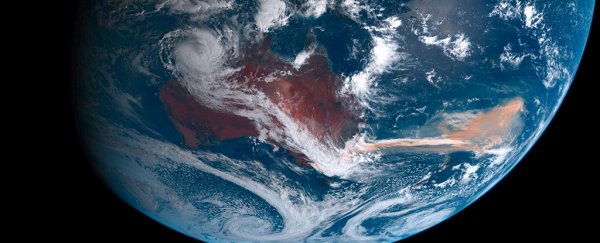As well as the local and immediate threat to life and property they present, bushfires can also have far-reaching, long-lasting consequences for the rest of the planet, as was the case with the huge Australian bushfires of the summer of 2019/2020.
A new study combining satellite data with measurements in the field reveals one of these consequences: a giant phytoplankton bloom larger than the entirety of Australia, located in the northernmost waters of the Southern Ocean, to the south east of Australia.
Such huge spikes in organic material aren't quite the win for marine ecosystems we might imagine. Quite the opposite, as the vast cloud of organisms can make for a potential toxic soup in the ocean.
"Explosive blooms of plankton can be deadly to animals," says paleobiologist Chris Hays from the Swedish Museum of Natural History, who wasn't involved with the research.
"A single bloom event can wipe out countless thousands of animals in a few days, and leave 'dead zones' in freshwater lakes and coastal areas."
That's in addition to the devastating effect that the bushfires had on wildlife on land, the hundreds of people who died in the blazes, and many other impacts – like turning some of the glaciers in New Zealand brown with ash and dust.
"The phytoplankton bloom in this region was unprecedented in the 22-year satellite record and lasted for around four months," says biological oceanographer Pete Strutton from the University of Tasmania in Australia.
"What made it more extraordinary is that the part of the season when the bloom appeared is usually the seasonal low point in phytoplankton, but the smoke from the Australian bushfires completely reversed that."
Aerosols in the bushfire smoke are likely the reason behind the vast microalgae bloom, the researchers say. They first tracked the path of the smoke across the ocean to link it to the phytoplankton, with stratospheric winds directly affected by the plumes.
The low but significant concentrations of iron in the smoke would have been feasted upon by microscopic ocean plants, which need it for photosynthesis and growth, causing the stretch of phytoplankton to appear in the water.
Further analysis revealed that the deposits from the smoke raised the iron levels in the ocean to several times their normal level for the time of year, and the reaction to this increased food source was rapid.
"The acceleration in phytoplankton growth as the fires took hold in Australia was so quick that it only lagged the blazes by a few weeks and in some cases just days," says marine biogeochemist Jakob Weis from the University of Tasmania.
"This was even as the impact of the smoke was felt in fits and starts rather than appearing as a constant rain of smoke on the ocean. As an example, we found the fires on just one day, January 8, deposited 25 percent of the black carbon and iron for the whole of January into that part of the ocean."
In a second study, a separate team of researchers estimated that around 715 million tonnes of carbon dioxide were pumped out by the bushfires in the months they were raging – a much higher level than many previous estimates.
However, phytoplankton blooms act as carbon sinks. Such was the size of the one created by the bushfires, researchers think that it could have sucked in almost all of the carbon dioxide released by the burning.
A variety of factors affect phytoplankton photosynthesis and carbon capture – including available light and temperature – so it's not certain that the emissions would have been captured deep within the ocean.
What is certain is that events like the Australian bushfires have a major impact on the rest of our planet's ecosystem, with multiple considerations to take into account to work out the overall consequences for our climate.
"The size and the change in productivity was roughly equivalent to transforming the entire Sahara desert into a moderately productive grassland for several months," says Strutton.
"This work illustrates the enormous impact that aerosols from Australia can have thousands of kilometers away, which we wouldn't have known about if it weren't for global ocean observing systems."
The research has been published in Nature.
